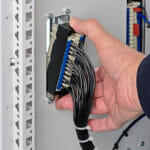Flexible Intermediate Bulk Containers (FIBCs) have long been considered a great innovation in the transportation of dry flowable material since their introduction in the sixties. Commonly referred to as a “bulk bag”, “big bag” or “tote”, FIBCs have a body made of flexible woven material, typically the high strength thermoplastic, polypropylene, along with a linear insert.
However, the use of FIBCs are not without their risks and when filling and emptying FIBCs in hazardous areas, electrostatic charge can accumulate on both the contents (product) and the fabric of the material itself. This can result in a dramatic incident, such as a flash that can result in an explosion and/or fire, as happened in these two cases.
In this incident, an FIBC Type C bag was used to transfer resin to a 6,000 gallon mixing tank. It was equipped with thin conductive wires running lengthwise through the spout and connected to a bare stranded aluminium wire and alligator clip. The FIBC was hoisted above the tank using a fork lift and the resin was dumped through a circular port on a hinged tank cover. There was no independent venting of displaced vapour and the tank lid was not gas tight. Despite the operator reporting that the ground wire was missing from the FIBC, it did not stop him proceeding to unload the container regardless.
An operator typically stands within close proximity of the FIBC during emptying, first to untie the strings and later to shake out residual powder. In this scenario an ignition occurred and the operator was caught in the flash-fire zone and severely burned in the process, including on their head, neck back and arm.
The investigation into the incident made the assessment that a spark discharge had occurred from the ungrounded FIBC during emptying. The lack of continuity to ground meant that charge could not be dissipated. Although the operator himself was not grounded, the nature of the operation involved making a lacquer, meaning that static dissipative footwear would probably have been ineffective as there was possibility of a film of lacquer on the floor around the tank.
Details about a similar incident within FIBC processes, that caused second and third degree burns to an operator, as well as industry-leading static electrical control solutions, can be obtained by contacting Newson Gale and requesting the latest FIBC case study.









